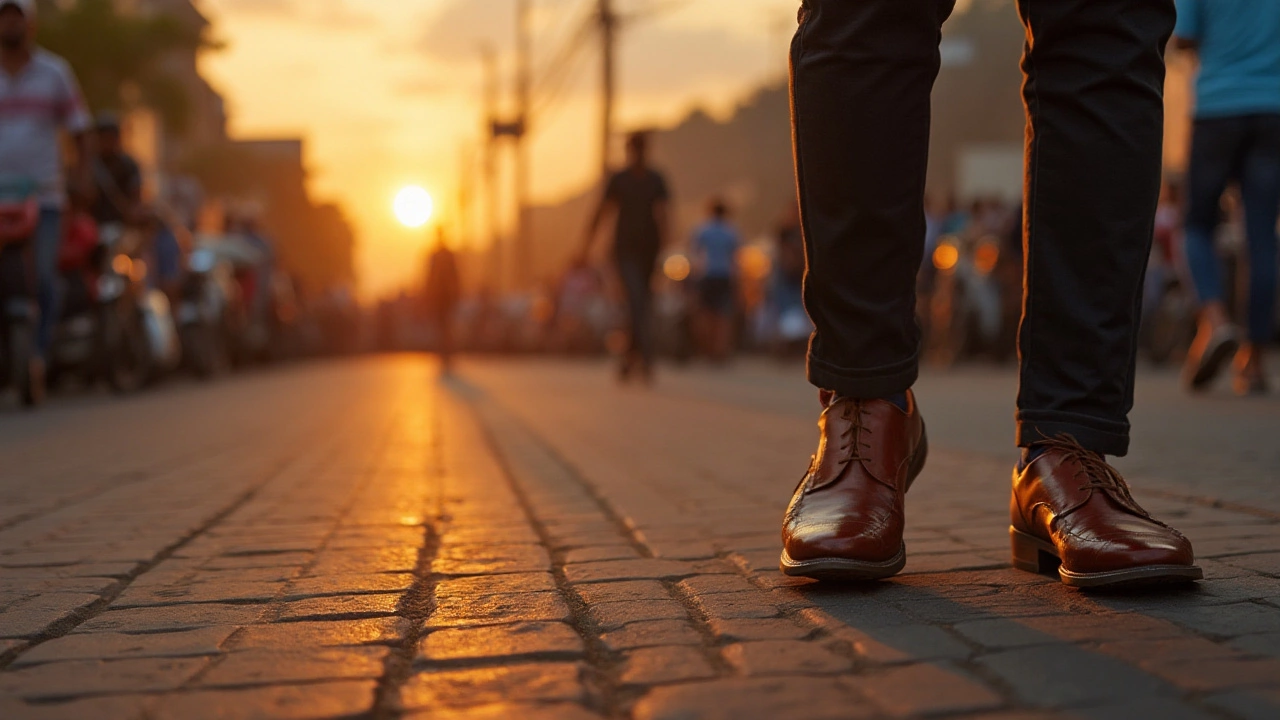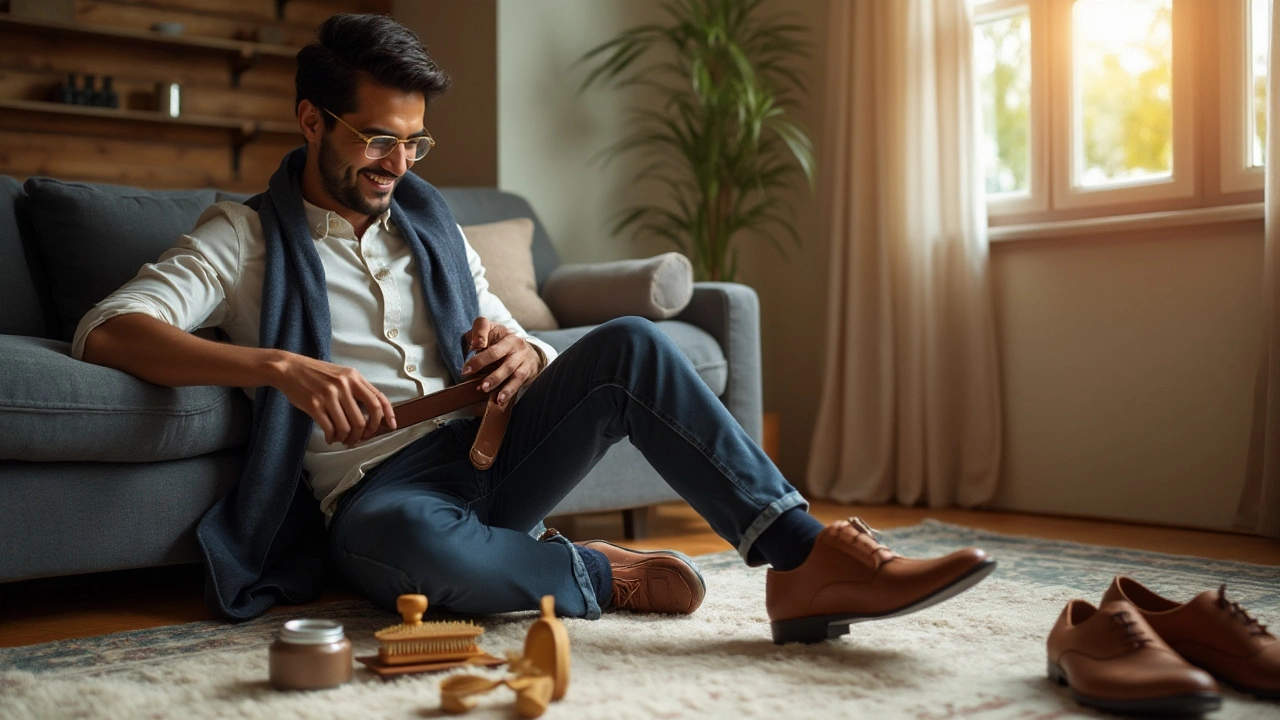Leather shoes possess a timeless appeal, but fresh out of the box, they might feel rigid and less than comfortable. Fortunately, this is a common feeling shared by many enthusiasts of leather footwear, and with some patience, you can transform your pair into your favorite go-to shoes.
The time it takes to break in a new pair of leather shoes can often feel longer than it actually is. Various factors – from the type of leather used to your personal walking style – influence this duration. Remember, perseverance pays off, and some shoes are known to fit like a second skin with just a bit of love and attention.
- Understanding Leather
- Expected Timeframe
- Wearing Techniques
- Shoe Care Essentials
- Troubleshooting Common Issues
Understanding Leather
Leather, a natural material, offers durability, protection, and a classic aesthetic that has transcended centuries of fashion evolution. Initially, leather can feel rather stiff, a characteristic primarily attributed to its inherent density and resilience. Quality leather is not merely a protective covering; it is a living material that reacts to the environment and usage patterns. Understanding this is crucial when considering the time it takes to break in leather shoes. The break-in period is a dance between rigidity and flexibility, where leather gradually molds to the shape of your foot, allowing it to cradle each curve uniquely.
Various types of leather, such as full-grain, top-grain, or suede, impact the break-in period differently. Full-grain leather, known for its robustness and minimal processing, generally takes a longer time to become soft and pliable, but ultimately, its reward lies in unmatched strength and longevity. On the other hand, suede, with its soft finish and lighter texture, often embraces the foot with less initial stiffness, creating a more comfortable initial experience. It is important to note that leather's quality and treatment during manufacturing can drastically influence how it feels on the feet.
From the laborious process of tanning to the careful art of finishing, leather shoes are a product of skilled craftsmanship. Tanning, the most crucial step, chemically stabilizes the material, preventing decay while enhancing its flexibility. Vegetable tanning, a method involving natural tannins from plant extracts, is traditional yet offers a unique depth of color and firmness. Chromed leather, tanned with chromium salts, is softer, absorbing less water and thus maintains its shape well.
"Leather working teaches patience and respect for the material, connecting us with centuries-old traditions," a notable craftsman once said, illustrating how each pair of shoes almost gains a spirit of its own as it undergoes these processes.
Another pivotal aspect of leather is its ability to develop a 'patina' over time. This natural sheen and deep color enhance its beauty, forming through wear and exposure to various elements like sunlight or moisture. While the patina can provide a personalized appearance that reflects your unique lifestyle, it also serves as a testament to the leather's adaptability and strength. Indeed, when it comes to shoe care, understanding leather's properties opens the door to more mindful and effective maintenance practices.
Leather footwear involves not just the artistry of shoemakers, but also the interaction between the wearer's lifestyle and the shoes themselves. With proper care – involving regular conditioning and occasional polishing – leather shoes can provide decades of service, adapting and evolving alongside their owner. This capacity for change is a hallmark of leather, enabling it to conform and transform, ultimately offering comfort that synthetic materials may fail to match. Recognizing this harmony between material and wearer explains why leather remains a steadfast choice for shoe lovers worldwide.
Expected Timeframe
When it comes to breaking in a new pair of leather shoes, patience and time are critical components of ensuring a comfortable fit. Generally, the timeframe can vary significantly from person to person and shoe to shoe, but a common range falls between a few days to a couple of weeks. The process tends to differ based on several factors including the brand, type of leather, construction methods, and personal wear patterns. It's important to consider these elements to avoid frustration and expedite the process.
Understandably, the thought of enduring discomfort during this period is daunting. However, most leather shoes begin to show signs of softening after just a few wears. The type of leather plays a crucial role here; for example, softer leathers such as calfskin might require less time compared to tougher full-grain leather. Some people find success in breaking in their pair within a week by wearing them for short periods each day, gradually increasing the duration as the days pass.
Interestingly, the inner workings of leather as a material contribute to its gradual adaptability. Leather is composed of fibers that, over time, begin to mold and shape to the contours of your feet. This transformative ability is what gives leather footwear its unique and personalized fit. As they adapt, areas that initially felt tight will noticeably loosen and contour, transforming the once-stiff shoes into a pair you look forward to wearing.
"Leather shoes may initially seem stiff but remember, their main characteristic is adaptability," says footwear expert James Green. "Give them time and some strategic use, and they'll soon become your most comfortable pair."
To break in your new leather shoes, one suggestion is to wear them indoors for shorter periods, especially for less robust styles like loafers and Oxfords. This way, you can better gauge any pressure points in a controlled environment without committing to a day out that could leave you with sore feet. Over time, increasing your wear time is key to ensuring your shoes become supple and comfortable. It's often helpful to wear slightly thicker socks during this process to aid in stretching out the shoes faster.
Your routine can also include using shoe stretchers, or applying a premium shoe conditioner, which not only aids in the break-in process but gives your shoes a longer lifespan by keeping the leather nourished. Conditioning allows the fibers of the leather to relax, facilitating the molding process. By understanding and respecting the break-in timeframe of leather shoes, you can ensure a smoother and more comfortable transition, leading to a rewarding and comfortable wearing experience.

Wearing Techniques
Breaking in a pair of leather shoes can feel like an adventure filled with discovery. Wearing them around the house is one of the most effective techniques for easing into this journey. Begin by slipping your leather footwear on in the evening while relaxing at home. This way, the shoes are not subjected to the harsh realities of the outdoors right off the bat. Pair them with thick socks; it might surprise you how much this can aid in stretching the leather and making the initial stiffness more bearable. This gradual wear indoors minimizes blisters and helps in recognizing potential pressure points.
When migrating your wearing experience from personal spaces to the public sphere, opt for short outings initially. This step is crucial in avoiding a rush that could lead to undue discomfort or even damage to your shoes. It's no secret that walking longer distances in yet-to-be-broken-in shoes can be an ordeal. Experts often recommend adjusting the lacing or buckles during these early stages to ensure they provide a snug, yet comfortable fit. Over time, as your foot begins a harmonious dance with the shoe, the material behaves like your favorite old leather chair, molding perfectly to the shape of your foot.
"Breaking in shoes is not just about wearing them; it's about understanding how they complement your foot's natural movement," says John Lobb, a revered name in shoemaking.
Integrating shoe-stretching tools can be particularly advantageous, especially when faced with seemingly stubborn sections. These devices can target specific areas like the toe box or heel to provide that extra bit of ease. However, they're best used with care and only after giving the natural wear method a genuine try. Remember, patience remains a virtue in the world of shoe comfort tips, and sometimes allowing time to play its part is the best strategy. Incorporate these techniques with consistency, and you'll find your shoes becoming not just an accessory but a partner in comfort.
Regularly swapping out your shoes can also play a pivotal role in their break-in. Engaging different pairs allows the leather adequate time between wears to naturally mold and adapt to your foot's unique contours without too much stress. This doesn't just boost comfort – it prolongs the shoe's lifespan. Cultivating a habit of rotating your collection ensures they maintain their shape for as long as possible. Letting them breathe rejuvenates the leather, keeping it supple – this aligns closely with core shoe care principles.
Shoe Care Essentials
Taking care of your leather shoes is as essential as breaking them in for comfort and longevity. The first step involves regular cleaning. Leather tends to accumulate dust and moisture, both of which can damage the fibers if left unattended. Using a soft brush or damp cloth, gently remove dirt and grime after each wear. It's equally important to condition your shoes. Leather is skin, and it needs moisture to maintain its elasticity and luster. High-quality leather conditioners penetrate deep into the material, preventing cracking and adding a layer of protection. Applying the conditioner every few weeks is a game-changer for durability and appearance.
Polishing is the next step for preserving the rich hues of the leather. A quality polish not only enhances the shoe's color but also provides a barrier against water and stains. Choose a polish that matches the shoe's color, and apply it in small circles with a cloth. Allow it to sit briefly before buffing it with a clean brush for a gleaming finish. Additionally, waterproofing is crucial, especially in wet climates. A spray-on protectant helps repel water, ensuring your shoes last even during unpredictable weather.
Another often overlooked aspect of shoe care is proper storage. Storing leather shoes correctly prevents deformities and maintains their structure. Shoe trees made of cedar are advantageous as they absorb moisture and odors while maintaining the shoe's shape. When traveling, consider using shoe bags to avoid scratches and scuffs that can occur in transit. Regular inspections for wear and tear, particularly at the soles and heels, are vital. Prompt repairs by cobblers can extend the life of your shoes significantly, saving you from premature replacements.
Additional Tips for Maintaining Leather Shoes
Ensuring the longevity of your leather shoes involves not only routine care but also timely rotation. Avoid wearing the same pair two days in a row to allow them to air out and recover from moisture absorption. This prolongs their lifespan and keeps them fresh. Furthermore, using a shoe horn for assistance when putting on your shoes prevents unnecessary creasing and damage."Caring for leather is about more than just keeping shoes clean; it's an investment in quality that enhances their beauty and extends their life." — Shoe connoisseur, John Lobb.
In conclusion, understanding these fundamental aspects of shoe care can significantly enhance your experience with leather footwear. From cleaning and conditioning to waterproofing and polishing, each step plays a part in preserving the elegance and functionality of leather. So, embrace this routine, and your investment in leather shoes will continue to pay off, looking sharp and feeling comfortable for many years to come.

Troubleshooting Common Issues
Breaking in leather shoes can sometimes bring about a few hiccups on your journey to achieving that perfect fit. One common problem many face is the persistent rubbing that occurs at the heel or toes, which can lead to blisters. If this is your experience, you’re not alone. Blisters are a frequent foe that most leather shoe wearers encounter, especially during the initial period of wear. A simple home remedy involves applying a moisturizing lotion or rubbing alcohol to the inner surfaces of the shoe, allowing the leather to soften and adapt. This transforms the shoe into a more comfortable and heel-friendly fit over time. Many also advocate for wearing thicker socks initially to maintain a barrier between your skin and the unyielding leather.
Another issue that might surface is the notorious squeak that seems to announce your presence before you even arrive. This commonly arises when the insoles or the outsole haven't settled yet into their structure, producing air pockets that cause sound. Sprinkling a little baby powder or talc between the shoe and the insole can help absorb moisture and give these surfaces the freedom to move silently. Alternatively, ensure your shoes are completely dried and well-conditioned, as moisture often exacerbates the problem. This unwanted noise can be silenced with patience and the right tips at hand.
If your leather footwear feels excessively tight but you can't bear the thought of returning them, consider the option of a shoe stretcher. Utilizing one overnight, with gentle adjustments each time, can gradually increase both width and length to accommodate a better fit. You may also consult professionals who offer stretching services. Their equipment is usually more sophisticated and tailored to individual needs. It's important to address tightness promptly, as persistent discomfort can damage the structure of the shoe over time, leading to misshapen leather.
Creasing in leather shoes is often unavoidable, yet for some, it represents a blemish in their aesthetic charm. The occurrence of creases can be lessened by rotating shoe wear and affording each pair a day of rest between uses. The gentle use of shoe trees can maintain shape, especially when paired with regular cleaning and conditioning. A thoughtful approach to care ensures that your shoes not only look their best but also last longer, maintaining that sought-after comfort.
"Quality leather shoes, with the right care, not only fit better over time but also exude uniqueness, comfort, and durability," said renowned footwear specialist, John Smith.
Finally, if you find that your shoes start showing signs of wear earlier than expected, it could stem from incorrect cleaning techniques or exposure to unwelcome elements. Water stains, for instance, can be gently buffed out with a combination of vinegar and water, followed by conditioning. Always store shoes in a cool, dry space, and when cleaning, use products that are specifically designed for leather, ensuring each pair lives its fullest life.

